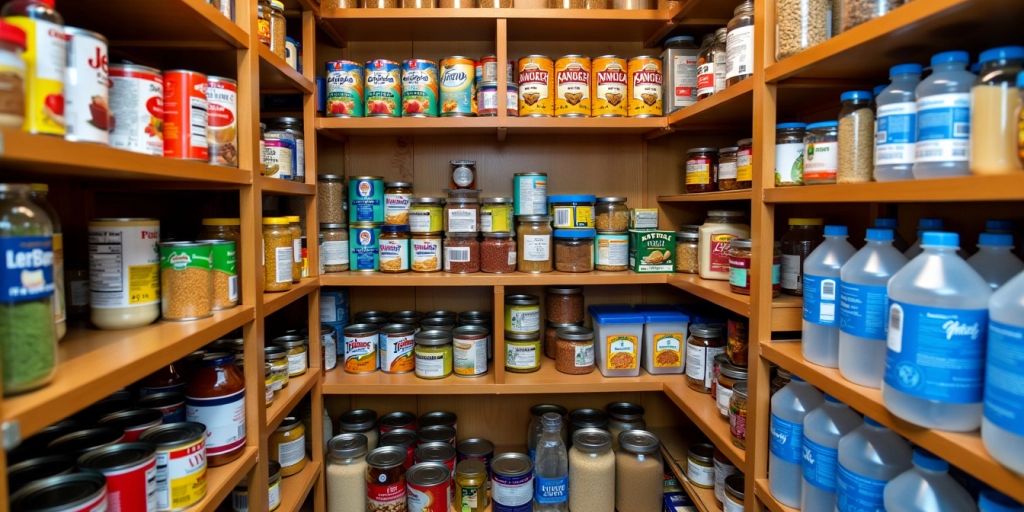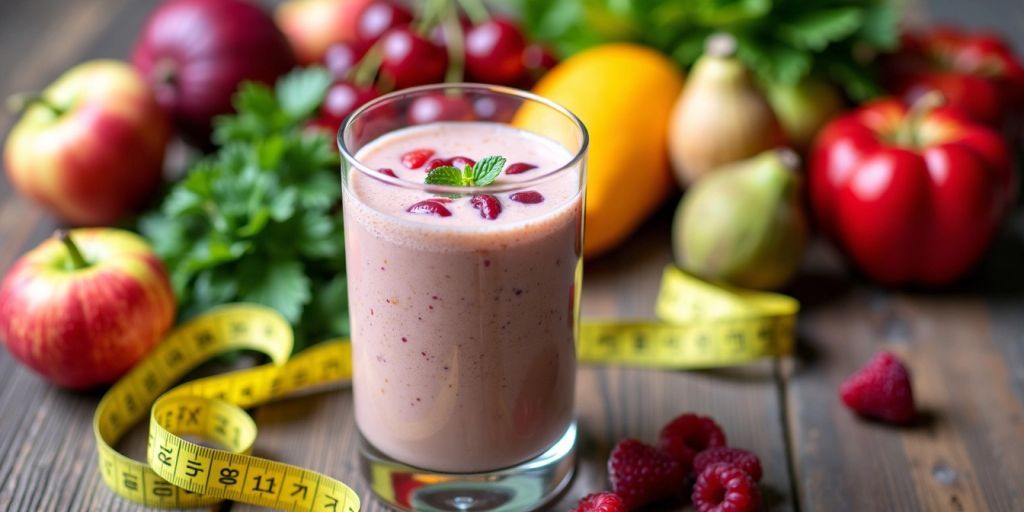Emergencies can happen without warning, leaving you and your family in a tough spot. Having a well-stocked emergency food supply can make a big difference. This guide will help you understand the essentials of emergency food storage, from choosing the right foods to storing them properly. Let’s get started on preparing for the unexpected.
Key Takeaways
- Nut butters are a great source of protein and healthy fats, and they don’t need refrigeration.
- It’s crucial to store enough water—about one gallon per person per day for at least two weeks.
- Granola and protein bars provide quick energy and have a long shelf life.
- Canned goods are convenient and packed with nutrients, making them ideal for emergencies.
- Liquid meal replacements can offer complete nutrition when other food options are limited.
Understanding the Basics of Emergency Food Storage
Why Emergency Food Storage Matters
Emergency food storage is crucial because it helps you stay prepared for unexpected situations like natural disasters, economic crises, or other emergencies. Having a stockpile of food and water ensures you can sustain yourself and your family during tough times. It’s not just about survival; it’s about maintaining a sense of normalcy and security when everything else seems uncertain.
Types of Emergencies to Prepare For
There are various types of emergencies you should be ready for, including:
- Natural disasters (e.g., hurricanes, earthquakes, floods)
- Economic downturns or job loss
- Pandemics or health crises
- Power outages or infrastructure failures
Each type of emergency may require different preparations, but having a well-rounded food storage plan can cover most scenarios.
Basic Principles of Food Storage
When it comes to storing food for emergencies, there are a few basic principles to keep in mind:
- Diversity: Store a variety of foods to ensure balanced nutrition. Include grains, proteins, fruits, and vegetables.
- Shelf Life: Focus on non-perishable items that have a long shelf life. Rotate your stock to use older items first and replace them with new ones.
- Storage Conditions: Keep your food in a cool, dry, and dark place. Proper storage conditions can significantly extend the shelf life of your food.
- Packaging: Use airtight containers to protect your food from pests and moisture. Label everything with the purchase date and expiration date.
Remember, the goal is to create a food storage system that is sustainable and easy to manage. Start small and gradually build up your supplies without causing financial strain.
Choosing the Right Foods for Your Emergency Stockpile
Non-Perishable Essentials
When it comes to stocking your pantry for an emergency, non-perishable foods are a must. These items have a long shelf life and don’t require refrigeration. Some of the best options include canned goods, dried grains, and legumes. Canned goods like beans, vegetables, meat, and fruit are particularly useful because they can be eaten straight out of the can if necessary. Remember to have a can opener handy!
Nutrient-Dense Options
In an emergency, it’s crucial to have foods that are not only long-lasting but also packed with nutrients. Look for items that provide a good balance of carbohydrates, proteins, and fats. Dried fruits and nuts are excellent choices as they offer quick energy and essential nutrients. Additionally, consider adding vitamin and mineral supplements to your stockpile to ensure you’re getting all the necessary nutrients.
Foods for Special Dietary Needs
If anyone in your household has food allergies or dietary restrictions, make sure to include suitable options in your emergency stockpile. There are many non-perishable foods available that cater to specific dietary needs, such as gluten-free, dairy-free, and low-sodium options. It’s also a good idea to store extra amounts of these items in case of a prolonged emergency.
Planning ahead and considering your family’s specific needs can make a big difference in an emergency. A well-thought-out stockpile can provide peace of mind and ensure you have the resources to weather any storm.
By carefully selecting the right foods, you can create a balanced and nutritious emergency stockpile that will keep you and your family well-fed and healthy during any crisis.
Water: The Most Critical Resource

How Much Water to Store
When estimating how much water to include in your emergency supplies, it’s typically recommended that you stockpile at least one gallon of water per person per day for at least three days. This amount covers drinking, cooking, and basic hygiene needs. However, if you live in a hot climate or have young children, nursing mothers, or sick individuals in your household, you might need more.
Best Practices for Water Storage
Storing water properly is crucial to ensure it remains safe to use. Here are some tips:
- Use food-grade water storage containers.
- Keep water in a cool, dark place to prevent algae growth and contamination.
- Rotate your water supply every six months to maintain freshness.
- Consider using water purification tablets or bleach to treat stored water if necessary.
Purification Methods
In an emergency, your stored water might run out, or you might need to use water from questionable sources. Here are some purification methods to ensure your water is safe to drink:
- Boiling: Boil water for at least one minute to kill most pathogens.
- Filtration: Use a portable water filter to remove bacteria and protozoa. Some filters can also remove viruses.
- Chemical Treatment: Use water purification tablets or household bleach (unscented) to disinfect water. Follow the instructions carefully for the correct dosage.
Remember, having a reliable water supply is essential for your emergency preparedness. Plan ahead and ensure you have enough water to meet your family’s needs in any situation.
Nut Butters: A Tasty and Nutritious Staple
Benefits of Nut Butters
Nut butters are a fantastic addition to your emergency food storage. They are packed with protein and healthy fats, making them a great source of energy. Nut butters don’t need refrigeration, which is perfect if you lose power. Plus, they can be used in various ways, from spreading on bread to mixing into smoothies.
Different Types of Nut Butters
There are several types of nut butters to consider for your stockpile:
- Peanut Butter: The most common and affordable option.
- Almond Butter: A bit pricier but offers a different flavor and nutritional profile.
- Cashew Butter: Creamy and rich, great for a change of pace.
- Mixed Nut Butter: Combines various nuts for a unique taste and added nutrients.
Storage Tips for Nut Butters
To keep your nut butters fresh for as long as possible, store them in a cool, dark place. Make sure the lids are tightly sealed to prevent air from getting in. For long-term storage, consider powdered options like Augason Farms Peanut Butter Powder. This can be rehydrated as needed and has a longer shelf life than traditional nut butters.
Nut butters are not just tasty; they are a versatile and essential part of any emergency food supply. Whether you prefer peanut, almond, or cashew, having a variety of nut butters ensures you get the nutrients you need while enjoying different flavors.
Canned Goods: Convenient and Long-Lasting
Best Canned Foods to Stock
Canned foods are a great idea for your survival stockpile, given they’re shelf-stable and can be eaten straight out of the can if need be. Good emergency supplies in this department include:
- Canned Vegetables
- Canned Fruits
- Canned Meats
- Canned Soups
Nutritional Value of Canned Foods
Canned foods are not just convenient; they also pack a nutritional punch. For example, canned beans are an excellent source of protein, fiber, and iron. Canned tuna is rich in protein, omega-3 fatty acids, and selenium. These foods can be stored in a cool, dry place for up to 5 years, making them ideal for long-term storage.
Proper Storage Techniques
To maximize the shelf life of your canned goods, store them in a cool, dry place. Utilizing airtight containers, vacuum sealing, or oxygen absorbers can further extend the shelf-life of food by preventing contamination and oxidation. Regularly rotate your stock to ensure older items are consumed first. Monitor expiration dates closely and discard any expired items to maintain food safety and quality.
Having an adequate stockpile of food (and, of course, water) for contingencies is a critical step to take for resiliency.
Canned goods are durable and provide excellent protection against light, moisture, and oxygen. They are also relatively inexpensive and widely available, making them a staple in any emergency food supply.
Granola and Protein Bars: Quick Energy Boosters
Choosing the Right Bars
When it comes to emergency food storage, granola and protein bars are a must-have. They are convenient, tasty, and packed with energy. Look for bars that are low in sugar and high in protein to keep you fueled during an emergency. Some bars even offer added vitamins and minerals, making them a great choice for a balanced diet.
Nutritional Benefits
Granola and protein bars provide a quick source of energy, which is essential in an emergency. They are often fortified with essential nutrients like fiber, vitamins, and minerals. This makes them not only a convenient snack but also a nutritious one. Non-perishable food items like these can be a lifesaver when you’re on the road or stuck at home.
Shelf Life and Storage
One of the best things about granola and protein bars is their long shelf life. Most bars can last for several months, if not years, when stored properly. Keep them in a cool, dry place to ensure they stay fresh. Regularly check expiration dates and rotate your stock to keep your emergency food supply up-to-date.
Granola and protein bars are a simple yet effective way to ensure you have quick energy boosters on hand during any emergency. They are easy to store, nutritious, and can be a real lifesaver when you need a quick meal or snack.
Liquid Meal Replacements: Complete Nutrition in a Pinch
Advantages of Liquid Meals
Liquid meal replacements are a fantastic option for emergency food storage. They provide all the essential nutrients and calories your body needs when food supplies are low. You could actually live entirely off of these long-term meal replacements if necessary. They are especially useful when you don’t have access to a kitchen or cooking facilities.
Top Brands to Consider
When it comes to choosing a liquid meal replacement, there are several top brands to consider:
- Soylent: Known for its balanced nutrition and convenience. The Soylent Vanilla Meal Replacement Shake contains 16g of complete vegan protein and is ready-to-drink.
- Ensure: Offers a variety of flavors and is designed to provide complete, balanced nutrition.
- Huel: Provides a range of meal replacement options, including ready-to-drink bottles and powders.
Storage and Shelf Life
Storing liquid meal replacements is straightforward. Here are some tips:
- Keep them in a cool, dry place: This helps extend their shelf life.
- Check expiration dates: Rotate your stock to ensure you’re using the oldest items first.
- Seal properly: Once opened, consume the product within the recommended time frame to avoid spoilage.
Liquid meal replacements are a must-have for any emergency food supply. They offer a convenient and reliable source of nutrition when you need it most.
Freeze-Dried and Dehydrated Foods: Lightweight and Long-Lasting
Benefits of Freeze-Dried Foods
Freeze-dried foods are a fantastic option for emergency food storage. They are incredibly lightweight and have a long shelf life, often lasting up to 25 years. The freeze-drying process preserves the nutrients and flavor of the food, making it a healthy and tasty choice. One of the biggest advantages is their ease of preparation—just add water, and you’re good to go!
Best Freeze-Dried Foods for Storage
When it comes to stocking up, consider these freeze-dried options:
- Fruits: Strawberries, apples, and blueberries
- Vegetables: Peas, corn, and bell peppers
- Meats: Chicken, beef, and turkey
- Full meals: Pasta dishes, stews, and soups
These foods are not only nutritious but also versatile, allowing you to create a variety of meals even in an emergency.
How to Store Freeze-Dried Foods
Proper storage is key to maximizing the shelf life of your freeze-dried foods. Here are some tips:
- Keep them in a cool, dry place: Temperature fluctuations can affect the quality of the food.
- Use airtight containers: This helps to keep out moisture and pests.
- Label everything: Make sure to note the date of purchase and expiration date.
Remember, the goal is to have a reliable food source that you can count on when you need it most. Proper storage ensures that your freeze-dried foods remain safe and delicious for years to come.
By incorporating freeze-dried and dehydrated foods into your emergency stockpile, you can ensure that you and your family are well-prepared for any unexpected situation.
Creating a Balanced Emergency Food Plan
Balancing Macronutrients
When planning your emergency food supply, it’s crucial to balance macronutrients. Your body needs a mix of carbs, proteins, and fats to stay healthy. Carbs give you energy, proteins help repair tissues, and fats keep you full. Make sure your stockpile includes a variety of foods to cover all these bases.
Incorporating Vitamins and Minerals
Don’t forget about vitamins and minerals! These are essential for keeping your body functioning well. Include foods rich in vitamins A, C, and D, as well as minerals like calcium and iron. You can also add supplements to your stash to ensure you’re getting everything you need.
Planning for Caloric Needs
Everyone’s caloric needs are different. Adults generally need between 2,000 to 2,800 calories per day, while kids need less. Plan your food supply based on the number of people in your household and their specific needs. This way, you’ll have enough energy to get through any emergency.
Remember, a well-balanced emergency food plan is not just about surviving, but thriving. Make sure to include a mix of non-perishables and sturdy veggies and fruit to create your on-the-go emergency food kit. Our whole30 approved partners are a great place to start; you’ll be better prepared for whatever comes your way!
Budget-Friendly Tips for Building Your Emergency Food Supply
Buying in Bulk
One of the best ways to save money while building your emergency food supply is to buy in bulk. Bulk items often come at a lower cost per unit, making it easier to stock up without breaking the bank. Consider purchasing large bags of rice, beans, and pasta. These staples have a long shelf life and can be used in a variety of meals.
Affordable Nutrient-Rich Foods
You don’t need to spend a fortune to get nutrient-rich foods. Look for affordable options like canned vegetables, dried fruits, and whole grains. These items are not only budget-friendly but also packed with essential nutrients. Canned goods are especially useful as they can be eaten straight out of the can if necessary.
DIY Food Storage Solutions
Creating your own food storage solutions can also save you money. Use airtight containers to store bulk items and keep them fresh for longer. Label each container with the purchase date to ensure you use the oldest items first. This method helps you avoid waste and ensures your food supply stays fresh.
In 4 simple steps, you can create an emergency food supply kit that will save you money and time. Get prepared before the storm hits you!
By following these tips, you can build a comprehensive emergency food supply without spending a lot of money. Start small, buy a few items each week, and soon you’ll have a well-stocked pantry ready for any emergency.
Conclusion
Preparing for emergencies doesn’t have to be a daunting task. By taking small steps now, you can ensure that you and your family are ready for whatever comes your way. Stocking up on essential food items like canned goods, nut butters, and bottled water can make a big difference in a crisis. Remember, it’s not just about survival; it’s about maintaining your health and well-being during tough times. So start building your emergency food storage today, and you’ll have peace of mind knowing you’re prepared for the unexpected.
Frequently Asked Questions
Why is emergency food storage important?
Emergency food storage is crucial because it ensures you have enough food during unexpected events like natural disasters or power outages. It helps you stay prepared and reduces stress during emergencies.
What types of food should I include in my emergency stockpile?
You should include non-perishable items like canned goods, nut butters, granola bars, and freeze-dried foods. It’s also important to have nutrient-dense options and foods that meet any special dietary needs.
How much water should I store for emergencies?
You should store at least one gallon of water per person per day. It’s recommended to have a two-week supply of water for each person in your household.
How can I make sure my emergency food stays fresh?
Store your emergency food in a cool, dry place away from direct sunlight. Use airtight containers to keep out moisture and pests, and regularly check expiration dates to rotate your stock.
Are there any budget-friendly ways to build an emergency food supply?
Yes, buying in bulk and choosing affordable, nutrient-rich foods can help you build an emergency food supply without breaking the bank. DIY food storage solutions can also save money.
What are the benefits of including nut butters in my emergency food storage?
Nut butters are a great source of protein and healthy fats. They don’t require refrigeration, making them ideal for emergency situations where you might not have access to electricity.
How long do granola and protein bars last in storage?
Granola and protein bars can stay fresh for at least six months when stored properly. They are convenient and provide a quick energy boost during emergencies.
What are the best practices for storing water?
Store water in clean, food-grade containers. Keep the containers in a cool, dark place. It’s also a good idea to have water purification methods on hand in case your stored water runs out.



